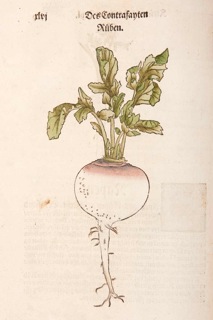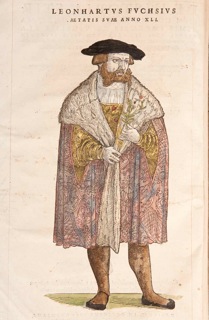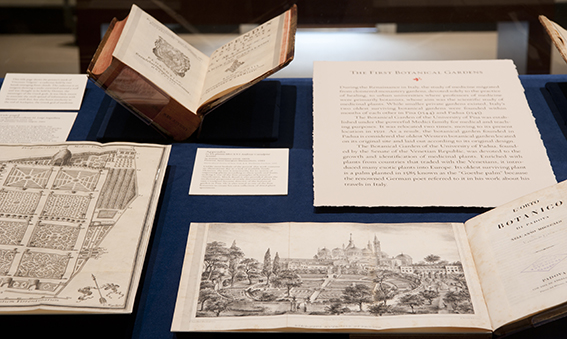Humble Turnip Stands Tall at Mertz Library Gallery
Posted in Exhibitions, From the Library on June 19 2013, by Joyce Newman
Joyce H. Newman holds a Certificate in Horticulture from The New York Botanical Garden and has been a Tour Guide for over seven years. She is the former editor of Consumer Reports GreenerChoices.org.
 A fascinating showcase of rare, stunningly illustrated books—dating from medieval and Renaissance times—is now open to the public in the Rondina and LoFaro Gallery at the Mertz Library.
A fascinating showcase of rare, stunningly illustrated books—dating from medieval and Renaissance times—is now open to the public in the Rondina and LoFaro Gallery at the Mertz Library.
Dozens of amazing works on display, called “Herbals,” contain some of the earliest ever recorded descriptions of plants in Western civilization, written by European botanists, physicians, historians, and clergy. Exhibitions Coordinator Mia D’Avanza explains how the exhibit was first conceived more than two years ago.
“There is a curatorial team from the Library that changes with each show, and often we choose a knowledgeable curator from outside the Garden who is an expert in the subject of that exhibition…. Our curator for this show, Lucia Tongiorgi Tomasi, an art historian at Italy’s University of Pisa, advised us as we chose works from the Library’s collection and described their significance.”
One such work includes a lovely image of a turnip (Brassica rapa), also featured on an eight-foot-tall poster placed just outside the gallery entrance. The image is from Otto Brunfels’ Contrafayt Kreüterbüch (1532-37), which can be seen inside a glass case with other German herbals.
“It is rare to see the humble turnip presented so beautifully,” says D’Avanza. “In the text corresponding to the drawing, Brunfels writes that the turnip can be ingested against poison and snakebites, or cooked and mashed to heal feet that have been damaged by the cold.” Who knew? Turnip lovers be amazed.
D’Avanza says it’s hard for her to pick a favorite from among so many wonderful books, but like many others she is “very partial” to Leonhart Fuchs’ De Historia Stirpium (1542) for the beauty of the plant illustrations and the portrait of Fuchs himself.
 “I love seeing how authors choose to depict themselves in their works, and Fuchs seems to be slightly smiling as he stands in his fur robe and tights with a flower in hand. He doesn’t look stern like some others do in their portraits. He looks pleased and relaxed.”
“I love seeing how authors choose to depict themselves in their works, and Fuchs seems to be slightly smiling as he stands in his fur robe and tights with a flower in hand. He doesn’t look stern like some others do in their portraits. He looks pleased and relaxed.”
Besides his wonderful portrait, Fuchs’ work—as well as Brunfel’s turnip—exemplify the impact of the invention of printing on the spread of botanical knowledge throughout Europe. The printing press made possible the efficient mass-production of books. These botanical texts were among the first to be printed in the vernacular in addition to Latin, making them useful to a wide range of readers.
In many ways this exhibit proves that knowing the healing powers of plants was just as popular thousands of years ago as it is today. To see more from The Renaissance Herbal, you can view a slideshow here.
The gallery show is part of the Wild Medicine exhibition at NYBG and is drawn from the manuscript collections of the Garden’s Mertz Library, the largest botanical and horticultural library in the world. To learn more, visit the exhibition page.


